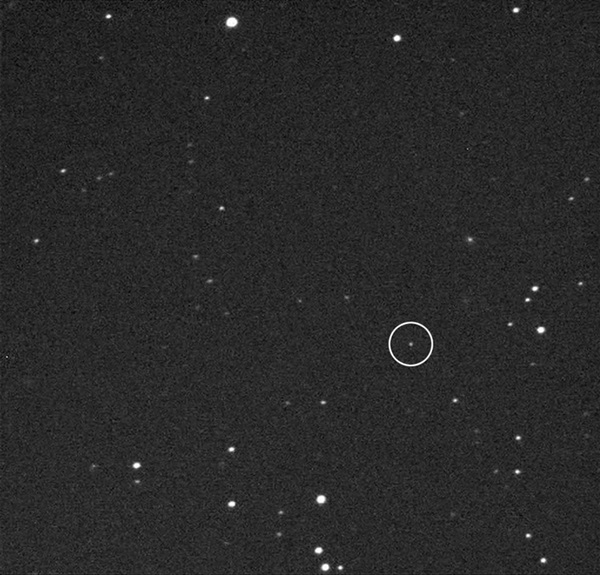Amateur astronomers, including Nick James of Chelmsford, Essex, England, have captured video of the interesting object. James generated his video of GP59 on the night of April 11. The video, captured with an 11-inch Schmidt-Cassegrain telescope, is a compilation of 137 individual frames, each requiring 30 seconds of exposure. At the time, the asteroid was approximately 2,100,000 miles (3,400,000 kilometers) distant. Since then, the space rock has become something of a darling of the amateur astronomy community, with many videos available. Here is one recent posting:
http://www.youtube.com/watch?v=O7wsAZNr56E
“Usually, when we see an asteroid strobe on and off like that, it means that the body is elongated, and we are viewing it broadside along its long axis first, and then on its narrow end as it rotates,” said Don Yeomans from NASA’s Jet Propulsion Laboratory in Pasadena, California. “GP59 is approximately 240 feet (50 meters) long, and we think its period of rotation is about 7.5 minutes. This makes the object’s brightness change every 4 minutes or so.”
Astronomers with the Observatorio Astronomico de Mallorca in Andalusia,Spain, discovered asteroid 2011 GP59 the night of April 8/9. It will make its closest approach to Earth April 15 at 12:09 p.m. PDT (19:09 UTC) at a distance just beyond the Moon’s orbit — about 330,000 miles (530,000 kilometers).
“Although newly discovered, the near-term orbital location of asteroid 2011 GP59 can be accurately plotted,” said Yeomans. “There is no possibility of the small space rock entering Earth’s atmosphere during this pass or for the foreseeable future.”
NASA detects, tracks, and characterizes asteroids and comets passing close to Earth using both ground- and space-based telescopes. The Near-Earth Object Observations Program, commonly called “Spaceguard,” discovers these objects, characterizes a subset of them, and plots their orbits to determine if any could be potentially hazardous to our planet.
Amateur astronomers, including Nick James of Chelmsford, Essex, England, have captured video of the interesting object. James generated his video of GP59 on the night of April 11. The video, captured with an 11-inch Schmidt-Cassegrain telescope, is a compilation of 137 individual frames, each requiring 30 seconds of exposure. At the time, the asteroid was approximately 2,100,000 miles (3,400,000 kilometers) distant. Since then, the space rock has become something of a darling of the amateur astronomy community, with many videos available. Here is one recent posting:
http://www.youtube.com/watch?v=O7wsAZNr56E
“Usually, when we see an asteroid strobe on and off like that, it means that the body is elongated, and we are viewing it broadside along its long axis first, and then on its narrow end as it rotates,” said Don Yeomans from NASA’s Jet Propulsion Laboratory in Pasadena, California. “GP59 is approximately 240 feet (50 meters) long, and we think its period of rotation is about 7.5 minutes. This makes the object’s brightness change every 4 minutes or so.”
Astronomers with the Observatorio Astronomico de Mallorca in Andalusia,Spain, discovered asteroid 2011 GP59 the night of April 8/9. It will make its closest approach to Earth April 15 at 12:09 p.m. PDT (19:09 UTC) at a distance just beyond the Moon’s orbit — about 330,000 miles (530,000 kilometers).
“Although newly discovered, the near-term orbital location of asteroid 2011 GP59 can be accurately plotted,” said Yeomans. “There is no possibility of the small space rock entering Earth’s atmosphere during this pass or for the foreseeable future.”
NASA detects, tracks, and characterizes asteroids and comets passing close to Earth using both ground- and space-based telescopes. The Near-Earth Object Observations Program, commonly called “Spaceguard,” discovers these objects, characterizes a subset of them, and plots their orbits to determine if any could be potentially hazardous to our planet.










